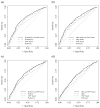Breast Cancer Risk Prediction Using Clinical Models and 77 Independent Risk-Associated SNPs for Women Aged Under 50 Years: Australian Breast Cancer Family Registry
- PMID: 26677205
- PMCID: PMC4767544
- DOI: 10.1158/1055-9965.EPI-15-0838
Breast Cancer Risk Prediction Using Clinical Models and 77 Independent Risk-Associated SNPs for Women Aged Under 50 Years: Australian Breast Cancer Family Registry
Abstract
Background: The extent to which clinical breast cancer risk prediction models can be improved by including information on known susceptibility SNPs is not known.
Methods: Using 750 cases and 405 controls from the population-based Australian Breast Cancer Family Registry who were younger than 50 years at diagnosis and recruitment, respectively, Caucasian and not BRCA1 or BRCA2 mutation carriers, we derived absolute 5-year risks of breast cancer using the BOADICEA, BRCAPRO, BCRAT, and IBIS risk prediction models and combined these with a risk score based on 77 independent risk-associated SNPs. We used logistic regression to estimate the OR per adjusted SD for log-transformed age-adjusted 5-year risks. Discrimination was assessed by the area under the receiver operating characteristic curve (AUC). Calibration was assessed using the Hosmer-Lemeshow goodness-of-fit test. We also constructed reclassification tables and calculated the net reclassification improvement.
Results: The ORs for BOADICEA, BRCAPRO, BCRAT, and IBIS were 1.80, 1.75, 1.67, and 1.30, respectively. When combined with the SNP-based score, the corresponding ORs were 1.96, 1.89, 1.80, and 1.52. The corresponding AUCs were 0.66, 0.65, 0.64, and 0.57 for the risk prediction models, and 0.70, 0.69, 0.66, and 0.63 when combined with the SNP-based score.
Conclusions: By combining a 77 SNP-based score with clinical models, the AUC for predicting breast cancer before age 50 years improved by >20%.
Impact: Our estimates of the increased performance of clinical risk prediction models from including genetic information could be used to inform targeted screening and prevention.
©2015 American Association for Cancer Research.
Conflict of interest statement
R. Allman is an employee of Genetic Technologies Ltd. G.S. Dite was in part supported by funding from Genetic Technologies Ltd.
Figures
Similar articles
-
10-year performance of four models of breast cancer risk: a validation study.Lancet Oncol. 2019 Apr;20(4):504-517. doi: 10.1016/S1470-2045(18)30902-1. Epub 2019 Feb 21. Lancet Oncol. 2019. PMID: 30799262
-
Evaluating the performance of the breast cancer genetic risk models BOADICEA, IBIS, BRCAPRO and Claus for predicting BRCA1/2 mutation carrier probabilities: a study based on 7352 families from the German Hereditary Breast and Ovarian Cancer Consortium.J Med Genet. 2013 Jun;50(6):360-7. doi: 10.1136/jmedgenet-2012-101415. Epub 2013 Apr 6. J Med Genet. 2013. PMID: 23564750
-
SNPs and breast cancer risk prediction for African American and Hispanic women.Breast Cancer Res Treat. 2015 Dec;154(3):583-9. doi: 10.1007/s10549-015-3641-7. Epub 2015 Nov 20. Breast Cancer Res Treat. 2015. PMID: 26589314 Free PMC article.
-
Performance of Single-Nucleotide Polymorphisms in Breast Cancer Risk Prediction Models: A Systematic Review and Meta-analysis.Cancer Epidemiol Biomarkers Prev. 2019 Mar;28(3):506-521. doi: 10.1158/1055-9965.EPI-18-0810. Epub 2018 Dec 18. Cancer Epidemiol Biomarkers Prev. 2019. PMID: 30563826
-
Polygenic risk prediction models for colorectal cancer: a systematic review.BMC Cancer. 2022 Jan 15;22(1):65. doi: 10.1186/s12885-021-09143-2. BMC Cancer. 2022. PMID: 35030997 Free PMC article.
Cited by
-
Breast cancer risk based on adapted IBIS prediction model in Slovenian women aged 40-49 years - could it be better?Radiol Oncol. 2020 Jul 2;54(3):335-340. doi: 10.2478/raon-2020-0040. Radiol Oncol. 2020. PMID: 32614783 Free PMC article.
-
Development and pilot testing of a leaflet informing women with breast cancer about genomic testing for polygenic risk.Fam Cancer. 2019 Apr;18(2):147-152. doi: 10.1007/s10689-018-0104-4. Fam Cancer. 2019. PMID: 30251170
-
Clinical Impact of Polygenic Risk Score for Breast Cancer Risk Prediction in 382 Individuals with Hereditary Breast and Ovarian Cancer Syndrome.Cancers (Basel). 2023 Aug 2;15(15):3938. doi: 10.3390/cancers15153938. Cancers (Basel). 2023. PMID: 37568754 Free PMC article.
-
Variance of age-specific log incidence decomposition (VALID): a unifying model of measured and unmeasured genetic and non-genetic risks.Int J Epidemiol. 2023 Oct 5;52(5):1557-1568. doi: 10.1093/ije/dyad086. Int J Epidemiol. 2023. PMID: 37349888 Free PMC article.
-
Age-specific breast cancer risk by body mass index and familial risk: prospective family study cohort (ProF-SC).Breast Cancer Res. 2018 Nov 3;20(1):132. doi: 10.1186/s13058-018-1056-1. Breast Cancer Res. 2018. PMID: 30390716 Free PMC article.
References
Publication types
MeSH terms
Grants and funding
- U01 CA069417/CA/NCI NIH HHS/United States
- U01 CA069638/CA/NCI NIH HHS/United States
- U01 CA69417/CA/NCI NIH HHS/United States
- UM1 CA164920/CA/NCI NIH HHS/United States
- CAPMC/ CIHR/Canada
- C5047/A10692/CRUK_/Cancer Research UK/United Kingdom
- 1U19 CA148065/CRUK_/Cancer Research UK/United Kingdom
- C5047/A8384/CRUK_/Cancer Research UK/United Kingdom
- R01 CA128978/CA/NCI NIH HHS/United States
- C1287/A 10710/CRUK_/Cancer Research UK/United Kingdom
- U19 CA148537/CA/NCI NIH HHS/United States
- C5047/A15007/CRUK_/Cancer Research UK/United Kingdom
- U01 CA69638/CA/NCI NIH HHS/United States
- R01 CA159868/CA/NCI NIH HHS/United States
- U01 CA69446/CA/NCI NIH HHS/United States
- U19 CA148065/CA/NCI NIH HHS/United States
- C1281/A12014/CRUK_/Cancer Research UK/United Kingdom
- U01 CA069446/CA/NCI NIH HHS/United States
- U01CA69631/CA/NCI NIH HHS/United States
- P30 ES009089/ES/NIEHS NIH HHS/United States
- CA128978/CRUK_/Cancer Research UK/United Kingdom
- 1U19 CA148537/CRUK_/Cancer Research UK/United Kingdom
- 1U19 CA148112/CRUK_/Cancer Research UK/United Kingdom
- U01 CA069467/CA/NCI NIH HHS/United States
- C12292/A11174/CRUK_/Cancer Research UK/United Kingdom
- U01 CA069398/CA/NCI NIH HHS/United States
- U01 CA069631/CA/NCI NIH HHS/United States
- U01 CA69398/CA/NCI NIH HHS/United States
- CA-06-503/CA/NCI NIH HHS/United States
- U19 CA148112/CA/NCI NIH HHS/United States
- C1287/A10118/CRUK_/Cancer Research UK/United Kingdom
- U01 CA69467/CA/NCI NIH HHS/United States
LinkOut - more resources
Full Text Sources
Other Literature Sources
Medical
Molecular Biology Databases
Miscellaneous


